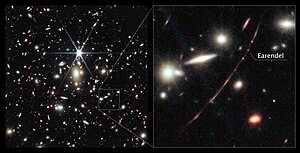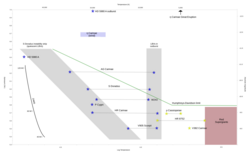Astronomy:WHL0137-LS
| Observation data Equinox J2000.0]] (ICRS) | |
|---|---|
| Constellation | Cetus |
| Right ascension | 01h 37m 23.232s[1] |
| Declination | –8° 27′ 52.20″[1] |
| Astrometry | |
| Distance | Comoving distance: 28 billion ly |
| Characteristics | |
| Spectral type | B[2] |
| Apparent magnitude (F435W) | 27.2[1] |
| Variable type | Luminous blue variable star |
| Details[3] | |
| if a single star | |
| Mass | 200 M☉ |
| Radius | 103 - 393 R☉ |
| Luminosity | 631,000 - 3,981,000 L☉ |
| Temperature | 13,000 - 16,000 K |
| if a binary (parameters highly uncertain) | |
| Radius | component 1: 23 R☉ component 2: 184 R☉ |
| Luminosity | component 1: 631,000 L☉ component 2: 200,000 L☉ |
| Temperature | component 1: 34,000 K component 2: 9,000 K |
| Other designations | |
Earendel | |
WHL0137-LS, also known as Earendel, is a star in the constellation of Cetus. Discovered in 2022 by the Hubble Space Telescope, it is the earliest and most distant known star, at a comoving distance of 28 billion light-years (8.6 billion parsecs).[4][5] The previous furthest known star, MACS J1149 Lensed Star 1, also known as Icarus, at a comoving distance of 14.4 billion light-years (4.4 billion parsecs),[6] was discovered by Hubble in 2018.[5] Stars like Earendel can be observed at cosmological distances thanks to the large magnification factors involved, that can exceed 1000. Other stars have been observed through this technique, such as Godzilla.
Observation
Earendel's discovery by the Hubble Space Telescope was reported on 30 March 2022.[1][7] The star was detectable due to gravitational lensing caused by the presence of the galaxy cluster WHL0137-08 between it and the Earth, concentrating the light from the star.[5] Computer simulations of the lensing effect suggest that Earendel's brightness was magnified between one thousand and forty thousand times.[8] The dates of Hubble's exposure to the star's light were 7 June 2016, 17 July 2016, 4 November 2019, and 27 November 2019.[9]
The star was nicknamed Earendel by the discoverers, derived from the Old English name for 'morning star' or 'rising light'.[1][10] Eärendil is also the name of a half-elven character in one of J. R. R. Tolkien's books, The Silmarillion, who travelled through the sky with a radiant jewel that appeared as bright as a star. NASA astronomer Michelle Thaller confirmed that the reference to Tolkien was intentional.[11] The star's host galaxy, WHL0137-zD1, was nicknamed "Sunrise Arc", because gravitational lensing distorted its light into a long crescent.[12][13]
Further observations by Hubble and the James Webb Space Telescope have been proposed to better define the properties of the star.[1][14] James Webb's higher sensitivity is expected to allow the analysis of Earendel's stellar spectra and determine whether it is actually a single star.[4][15] The spectral analysis would reveal the presence of elements heavier than hydrogen and helium, if any.[12]
On 30 July 2022, an image of Earendel was captured by the James Webb Space Telescope during its first imaging campaign of the star.[16]
On 8 August 2023, the colors of Earendel were detected, and an image was captured by both the Hubble and Webb telescopes.[17] Based on Webb's NIRCam data, Earendel is a "massive B-type star more than twice as hot as our Sun, and about a million times more luminous".[2]
Physical properties
The light detected from Earendel was emitted 900 million years after the Big Bang.[18][8] The star has been determined to have a 6.2±0.1 redshift,[1] meaning the light from Earendel reached Earth 12.9 billion years later.[19] Due to the expansion of the universe, the star's observed position is now 28 billion light-years away.[4] The previous most distant star, MACS J1149 Lensed Star 1, has a redshift of 1.49, and is now 14.4 billion light-years away.
If it is a single star, Earendel has a temperature of 13,000 – 16,000 K and a luminosity of 631,000 – 3,981,000 L☉, depending on the magnification. It is possible that Earendel might not be a single star as the spectral energy distribution of Earendel has a strong Balmer break, which is characteristic of stars with temperatures below 13,000 K and a blue UV slope which is present in stars with temperatures aboves 20,000 K. It is possible that Earendel is a binary with two components, where one is more luminous and much hotter (34,000 K) than the other one (9,000 K). Due to the limited amount of data, the parameters are not well constrained. If two stars are in the system, they could have different magnifications, which makes the parameters even more uncertain.[3]
See also
- List of star extremes
- List of the most distant astronomical objects
- Nature timeline
References
- ↑ 1.0 1.1 1.2 1.3 1.4 1.5 1.6 Welch, Brian (21 January 2022). "A Highly Magnified Star at Redshift 6.2". Nature 603 (7903): 1–50. doi:10.1038/s41586-022-04449-y. PMID 35354998. Bibcode: 2022Natur.603..815W.
- ↑ 2.0 2.1 Yan, Isabelle (2023-08-08). "Webb Reveals Colors of Earendel, Most Distant Star Ever Detected". http://www.nasa.gov/feature/goddard/2023/webb-reveals-colors-of-earendel-most-distant-star-ever-detected.
- ↑ 3.0 3.1 Welch, Brian; Coe, Dan; Zackrisson, Erik; Mink, S. E. de; Ravindranath, Swara; Anderson, Jay; Brammer, Gabriel; Bradley, Larry et al. (November 2022). "JWST Imaging of Earendel, the Extremely Magnified Star at Redshift z = 6.2" (in en). The Astrophysical Journal Letters 940 (1): L1. doi:10.3847/2041-8213/ac9d39. ISSN 2041-8205.
- ↑ 4.0 4.1 4.2 Kabir, Radifah (31 March 2022). "Hubble Detects Earendel, The Farthest Star Ever Seen. It's 28 Billion Light Years Away". ABP News. https://news.abplive.com/science/hubble-detects-earendel-the-farthest-star-ever-seen-it-s-28-billion-light-years-away-1522838.
- ↑ 5.0 5.1 5.2 Gianopoulos, Andrea (30 March 2022). "Record Broken: Hubble Spots Farthest Star Ever Seen". NASA. https://www.nasa.gov/feature/goddard/2022/record-broken-hubble-spots-farthest-star-ever-seen.
- ↑ Staff (2018). "Cosmological information and results: redshift z=1.49". Wolfram Alpha. http://www.wolframalpha.com/input/?i=redshift+z%3D1.49&a=FSelect_**LookbackTimeFromRedshift--.
- ↑ "Record Broken: Hubble Spots Farthest Star Ever Seen". Space Telescope Science Institute (NASA). 30 March 2022. https://hubblesite.org/contents/news-releases/2022/news-2022-003.
- ↑ 8.0 8.1 Timmer, John (30 March 2022). "Hubble picks up the most distant star yet observed". Nature (Ars Technica). doi:10.1038/s41586-022-04449-y. https://arstechnica.com/science/2022/03/hubble-picks-up-the-most-distant-star-yet-observed/.
- ↑ "Lensed Star Earendel". 30 March 2022. http://hubblesite.org/contents/media/images/2022/003/01FWRZTQFDGGP05KM1PRCCNZ1E.
- ↑ Parks, Jake (30 March 2022). "Hubble spots the farthest star ever seen". Astronomy. https://astronomy.com/news/2022/03/hubble-spots-the-farthest-star-ever-seen.
- ↑ Gohd, Chelsea (2022-03-31). "Meet Earendel: Hubble telescope's distant star discovery gets a Tolkien-inspired name" (in en). https://www.space.com/hubble-most-distant-star-tolkien-name-earendil.
- ↑ 12.0 12.1 Rauchhaupt, Ulf von (31 March 2022). "Der früheste Stern" (in de). https://www.faz.net/aktuell/wissen/weltraum/hubble-weltraum-teleskop-entdeckt-den-fruehesten-stern-17923622.html.
- ↑ Rennert, David (31 March 2022). "Hubble-Teleskop erspähte den mit Abstand fernsten Stern" (in de). https://www.derstandard.de/story/2000134555927/hubble-teleskop-erspaehte-den-mit-abstand-fernsten-stern.
- ↑ Coe, Dan; Welch, Brian; Acebron, Ana; Avila, Roberto; Bradac, Marusa; Bradley, Larry; Diego, Jose M.; Dimauro, Paola et al. (2021). "Monitoring Earendel, the Lensed z 6 Star". HST Proposal: 16668. Bibcode: 2021hst..prop16668C.
- ↑ Starr, Michelle (30 March 2022). "The Most Distant Single Star Was Just Detected, as Ancient as The Cosmic Dawn". ScienceAlert (Nature). doi:10.1038/s41586-022-04449-y. https://www.sciencealert.com/astronomers-have-detected-a-single-star-just-900-million-years-after-the-big-bang.
- ↑ Pultarova, Tereza (August 2, 2022). "James Webb Space Telescope glimpses Earendel, the most distant star known in the universe". https://www.space.com/james-webb-space-telescope-earendel-most-distant-star.
- ↑ Yan, Isabelle (2023-08-08). "Webb Reveals Colors of Earendel, Most Distant Star Ever Detected". http://www.nasa.gov/feature/goddard/2023/webb-reveals-colors-of-earendel-most-distant-star-ever-detected.
- ↑ Letzter, Rafi (30 March 2022). "Meet Earendel, the most distant star ever detected". The Verge. https://www.theverge.com/2022/3/30/23002980/earendel-hubble-most-distant-star-gravitational-lensing-jwst.
- ↑ Gianopoulos, Andrea (29 March 2022). "Record Broken: Hubble Spots Farthest Star Ever Seen". http://www.nasa.gov/feature/goddard/2022/record-broken-hubble-spots-farthest-star-ever-seen.
Coordinates: ![]() 01h 37m 23.232s, −08° 27′ 52.20″
01h 37m 23.232s, −08° 27′ 52.20″
 |




